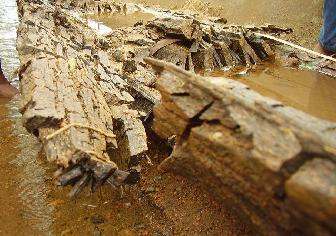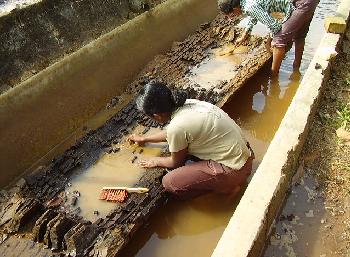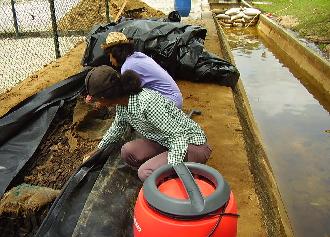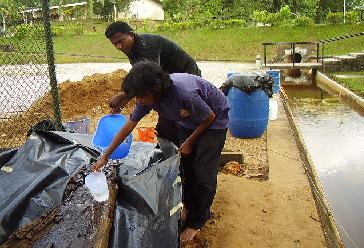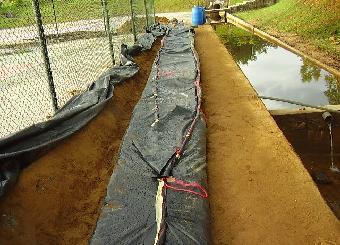Application of chemical and physical treatment to ancient paintings, sculpture and artifacts in order to minimize their deterioration due to natural or other causes, is the major role of the Chemical Conservation Division of the Department of Archaeology. By such treatment, it is expected to prolong the lifespan of ancient paintings, sculpture and artifacts and preserve them for posterity.
Although the Department of Archaeology of Sri Lanka was established in 1890, it had no Chemical Conservation Division until 1940s. During the early part of 1940s, there was a risk of the world famous Sigiriya cave paintings being discoloured and loosen its plastering. At that time, there was no expert in the island to take remedial measures. Hence Mr. Khan Bahadur Mohamed Sana Ulla, the chemist of the Indian Archaeological Department came to the island on 27th January 1943 and preserved Sigiriya cave paintings. He trained Mr. P. Don Ambrose in chemical conservation work and thus the Department of Archaeology gained ground for chemical conservation work.
After retirement from the Department of Archaeology in India Mr. Khan Bahadur Mohamed Sana Ulla came to Sri Lanka once again on 13th April 1947 and attended conservation of murals in the country, until August of that year. He played a major role in the conservation of Thivanka Pilima Geya in Polonnaruwa. He contributed immensely towards the conservation of mural paintings in the country taking special conservation measures at Lankathilaka Pilima Geya and Gal Vihara in Polonnaruwa in addition to other places such as Pulligoda and Hindagala.
The Department of Archaeology recruited a chemist for the first time on 1st of November, 1949 for carrying out conservation work. Mr. R.H. De Silva who has been recruited to the Conservation Division of the Department as an Apprentice Chemist received a training at Deradun in India under the Indian Archaeological Chemist.
In 1950, the plastering of Sigiriya cave paintings again got weakened and began to fall. Mr. Sarath Wattala, Draughtsman of the Department who had experience in working under Mr. Sana’ Ula was able to take remedial measures.
For the first time in 1953, a conservation laboratory was established in a building at the Music and Dancing Institute, Colombo. During the decades of 1950s and 1960s, the laboratory gradually advanced into high position and in addition to conservation of paintings, widened its activities into various spheres such as control of fungus and weeds in ancient monuments, strengthening of plastering, conservation of antiquities, conducting research and experiments for new conservation methods and manufacturing plastic replicas of inscriptions. The Conservation Laboratory was shifted to the modern laboratory building within the head office premises in Colombo in the early 1970s.
The night of 14th October 1967 was the most challenging night of the department history. That night, a vandal had destroyed the world famous Sigiriya painting by applying paint on them. This incident shocked the entire world. Restoration of the frescoes was a serious challenge to be taken over by the conservation Division of the Department. The conservation team headed by Dr. R.H.De Silva attended to the restoration work with great effort under the guidance of Italian expert Mr. Luciano Marency. Possibility of restoring and preserving the Sigiriya rock paintings for posterity was a triumphant victory of the Chemical Conservation division.
Restoring the destroyed Sigiriya frescoes
|
|
|
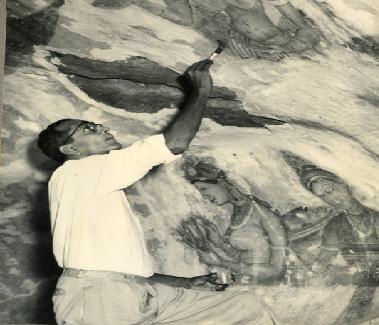
|
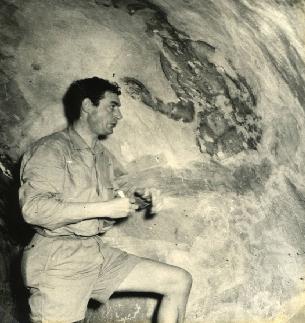
|
| Dr. R.H. De Silva |
Mr. Luciano Marency |
|
|
Restored Sigiriya Frescoes
|
|
|
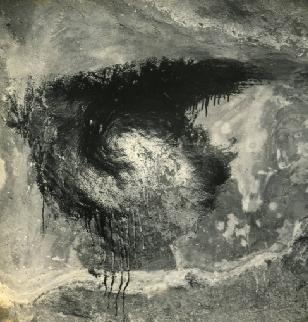
|
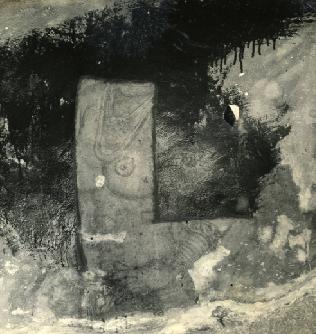
|
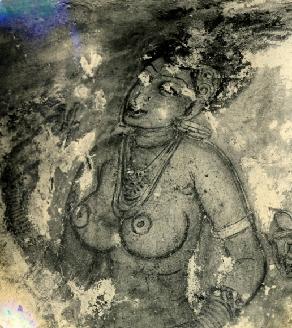 |
Administrative Hierarchy of the Chemical Conservation Division
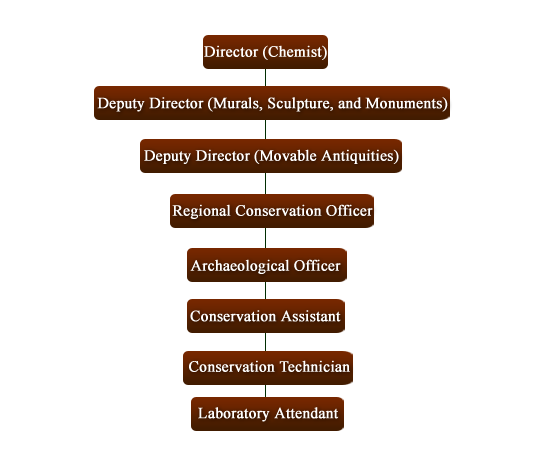
Role of The Chemical Conservation Division
All of the following activities related to chemical conservation are carried out under a scientific basis in accordance with nationally and internationally accepted conservation principles and ethics to obtain further information.
Click on the title to view more details
Sri Lanka inherits a continuous tradition of painting coming down from 3rd century B.C. Thousands of places with paintings representing different historical periods of the island are available all over the country. Of these paintings in Sigiriya, Dambulla cave temple and Thivanka Pilima Ge at Polonnaruwa have been declared as world heritage. Conservation of paintings and colured sculptures in these places and in other ancient Buddhist Viharas, churches, Kovils and caves is a major role of the Chemical Conservation Division. Apart from mural paintings and cave paintings, ancient paintings drawn on other surfaces such as textiles, canvas, leather, paper, clay utensils and timber are also to be conserved by the division. By now the Chemical Conservation Division has been able to perform conservation on paintings in fifty to sixty places annually, throughout the island.
Conservation of antiquities discovered through archaeological excavations and explorations carried out within the land and sea belonging to Sri Lanka, antiquities exhibited and stored in archeological museums of the department and antiquities received by the Department of Archaeology in any other form which require conservation is another major role of the Chemical Conservation Division. Thus movable antiquities of metal, timber, bone, ivory, textile, paper , ola books, leather, clay, glass and stone are being conserved by this division. Conservation work is carried out by bringing the antiquity concerned to the Conservation Laboratory at the Head Office by sending the conservation team to the site where the antiquity is kept. In this connection action has been, taken to establish mini laboratories attached to the regional archaeological museums.
Although conservation of immovable monuments is a function of the Architectural Conservation Division of the Department of Archaeology Chemical Conservation Division attends to strengthening of plastering of monuments, control of algae,………., fungus and weed and reconstruction stone statues and pillars.
Conservation Division also maintains a register embodying details of ancient paintings, coloured sculpture and coloured objects and a record of their photographs. A computerized data file embodying such details is also maintained while compact diskettes including photographs of them are also made. Although a painting is conserved chemically or physically, it will be subject to destruction in the passage of time and it is unavoidable, Hence keeping a record of such objects in the medium of photography is a conservation methodology. Main objective of doing so is to have systematic management of conservation of paintings and to create an Image Archive in future for the benefit of scholars who study ancient paintings of Sri Lanka.
Preparation of a register giving particulars of antiquities to be conserved from among those exhibited and stored in museums of the Department of Archaeology is also done by the Chemical Conservation Division. These particulars are included in a computerized data file. This is a project meant for identification of priorities in the process of conservation and for facilitation of conservation management.
Another major role of the Chemical conservation Division is to conduct research for finding more suitable new local methods of conservation and for identifying threats that cause deterioration of mural paintings, sculpture and antiquities. The Conservation Library functioning under the Chemical Conservation Division has approached a scientific approach for relevant analysis, research and experiments.
In instances where the original antiquity cannot be exhibited in museums or cannot taken to other types of exhibitions, replicas of such antiquity are created. A special project for this purpose is being planned by the Chemical Conservation Division.
Copying special mural painting is a measure taken for safeguarding the original paintings. Special attention has been paid to this work from the inception of the department. Chemical Conservation Division has taken steps to streamline this work.
Conservation of paintings once only is not sufficient. Agents which cause deterioration of paintings cab be active after sometimes. Hence position should be checked from time to time in order to minimize deterioration. Accordingly it is necessary to examine the position of paintings and the environmental factors affecting them and keep records of observation. This is another duty performed by the Chemical Conservation Division. In the meantime awareness programmes are conducted for owners of such sites on procedures to be followed for protecting the paintings.
Examination of movable and immovable antiquities (particularly antiquities exhibited in archaeological museums) after conservation to prevent them from further deterioration and maintenance of quality reports by examining environmental factors which lead to deterioration and conducting awareness programmes for officers in charge of museums on procedures to be followed for the protection of antiquities are also undertaken by this Division.
Every conservation and reconstruction should be systematically registered in an analytical and critical narration form together with photographs and maps in terms of note 16 of the International Declaration on Conservation and Reconstruction of Monuments and Sites. Accordingly the Chemical Conservation Division takes steps to prepre a report on every observation, conservation and research it undertakes. Facilities have been provided for any interested person to study such reports on written permission of the Director General of Archaeology.
Know - how of officers in the Chemical Conservation Division has to be updated frequently on modern conservation methodology and technology in order to enhance the quality of conservation process. Such knowledge is imparted to them through training workshops conducted in collaboration with international experts and organizations.
Programmes of imparting knowledge on chemical conservation to school children and university students and stimulating them for that purpose in order to educate them on the protection of our ancient heritage are being implemented.
Conservation of a Thousand Years Old Ferry
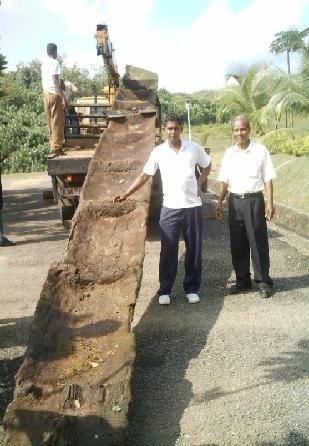 The Department of Archaeology received information in 1992, from the villagers of Lathpandura, Palindanuwara in the Kalutara District of the Western Province, Sri Lanka that an ancient wooden ferry was found in a stream of the area. Mr. Iyen Goffrey, expert conservationist of the Western Australian Museum came to Sri Lanka and examined the ferry in collaboration with Dr. Senarath Dissanayake, the then Assistant Director of the Exploration Division and the present Director General of Archaeology and prepared a conservation quality report and an estimate. A carbon 14 test proved that the ferry was approximately 960 years old. As a result of its removal from the water, it got dried and started to crack heavily. The Chemical Conservation Division launched a special project to conserve it by means of chemical treatment. It is now being prepared for public exhibition.
The Department of Archaeology received information in 1992, from the villagers of Lathpandura, Palindanuwara in the Kalutara District of the Western Province, Sri Lanka that an ancient wooden ferry was found in a stream of the area. Mr. Iyen Goffrey, expert conservationist of the Western Australian Museum came to Sri Lanka and examined the ferry in collaboration with Dr. Senarath Dissanayake, the then Assistant Director of the Exploration Division and the present Director General of Archaeology and prepared a conservation quality report and an estimate. A carbon 14 test proved that the ferry was approximately 960 years old. As a result of its removal from the water, it got dried and started to crack heavily. The Chemical Conservation Division launched a special project to conserve it by means of chemical treatment. It is now being prepared for public exhibition.
|
|
The ferry being inspected by the Director General of Archaeology after conservation
|
|
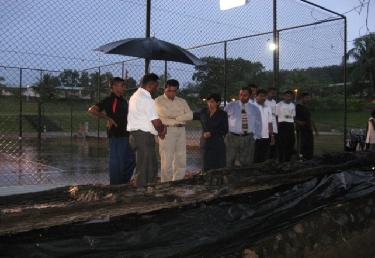 |
Another wooden ferry after Conservation
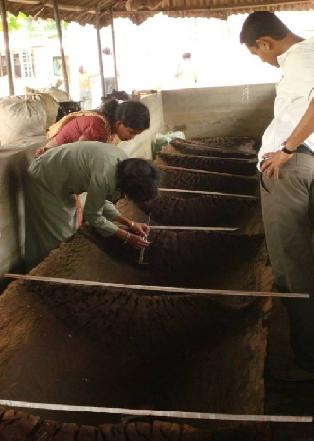 This was discovered in the Attanagalle Oya in March, 1998, in the Gampaha district of the Western Province. A carbon dating test performed by the Beta Analysis Organization, USA, proved that it was 1270 years old. It lay in water tank within the National Museum premises until its conservation bagan in 2008 under the Sri Lanka Netherland Cultural Cooperation Project. It was decided to be conserved in controlled environments, by air drying using wood powder. This method that doesn't use any chemical to avoid contraction, is a traditional one. To stop the growth of micro organisms, Boric acid and Borex were used. Whole wood powder saves money, the slow air drying prevents the amount of contraction as the wood dries up. The rate of contraction is continuously observed by the Department. Currently it is being prepared to be exhibited to the public.
This was discovered in the Attanagalle Oya in March, 1998, in the Gampaha district of the Western Province. A carbon dating test performed by the Beta Analysis Organization, USA, proved that it was 1270 years old. It lay in water tank within the National Museum premises until its conservation bagan in 2008 under the Sri Lanka Netherland Cultural Cooperation Project. It was decided to be conserved in controlled environments, by air drying using wood powder. This method that doesn't use any chemical to avoid contraction, is a traditional one. To stop the growth of micro organisms, Boric acid and Borex were used. Whole wood powder saves money, the slow air drying prevents the amount of contraction as the wood dries up. The rate of contraction is continuously observed by the Department. Currently it is being prepared to be exhibited to the public.
Conservation of the Ancient Artillery
In the year 2007, a group of fishermen who had gone to catch sea leeches discovered a copper mixed metal with technological features supposed to be belonged to the Portuguese period and while they were transporting it. Mundalama Police in Puttalam had taken it into custody and handed over to the Department of Archaeology. According to the opinion of Lieutenant Commodeor Somasiri Devendra as mentioned in page 140 of the 1976 book, the fact that it belongs to Portuguese period has been well established. The artillery has been found at a place in the sea about 15Km away from Mundalama sea beach in western Sri Lanka. It was kept in the Puttalam museum premises for several months and it was brought to Colombo Museum premises for chemical conservation. Funds for conservation were provided by the Ministry of Cultural Affairs under Sri Lanka - Netherland Cooperation Project. After conservation, this has been well placed in the Marine Archaeological museum in the Dutch building inside the Galle Fort for public view.
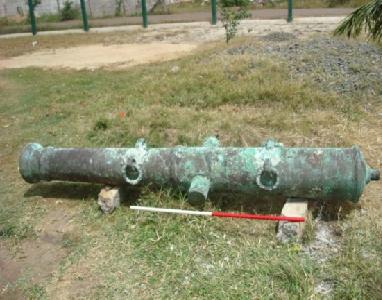 |
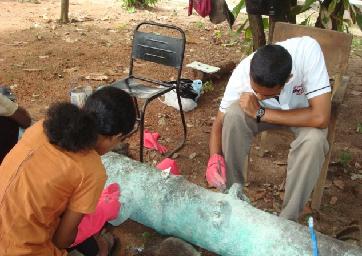 |
| The artillery before conservation |
|
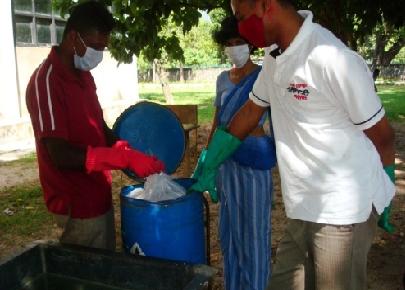 |
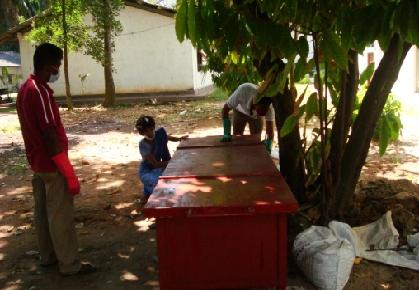 |
| Mechanized cleaning of the artillery using chemicals at the Archaeological Museum at Puttalam. |
Conservation of Buddha Statue at Ovagiriya
Ovagiriya archaeological site is in Ampara District in the Eastern Province of Sri Lanka. This ruined site was explored and discovered by the Department of Archaeology on request of the Gal Oya Development Board. Most of the ruins had been destroyed by the operation of tractors of the Gal Oya Development scheme. Ruins of a stupa, an image house, capital of stone pillars, guard stones, Korawak gal, flat tiles, etc. are scattered all over the site. The Chemical Conservation Division of the Department of Archaeology commenced conservation of the headless and handless Buddha statue of 11 ½ feet in height, in the year 2008. At the time of commencement of conservation, the shoulder portion of the statue was broken and fallen, on the ground. It was lifted and kept in the standing position with the help of a wooden frame and a lever.
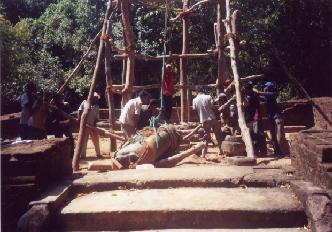 |
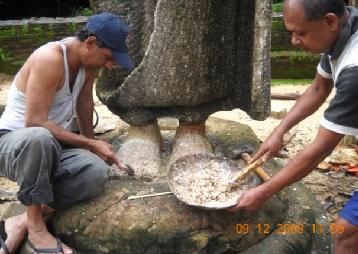 |
| Lifting the headless statue with the help of leavers. |
Recreation of two legs of the statue with a mixture of granite powder. |
|
|
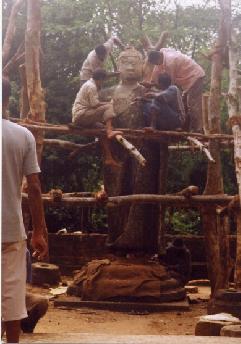 |
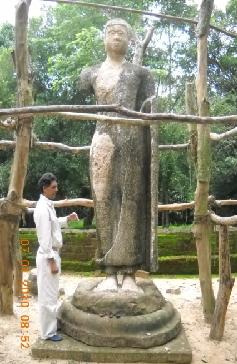 |
| After fixing the head to the body of the statue |
The statue after conservation. |
Ancient Fashions to the Modern Society
Chemical Conservation Division has started an ancient dress conservation project with the objective of providing opportunities to future generation to see dresses and fashions of the ancient society. As a first step of this project, several “kabakuruththu” dresses exhibited at E.W. Perera Memorial Museum at Kotte have been brought under conservation. “kabakuruththa” means a kind of dress worn by the middle class women lived in coastal areas during the Portuguese period to cover upper part of their body. It was type of short jacket with long sleeves made of white cotton cloth. It has a lace border around its neck. Wrists and the waist to look it more beautiful. Front portion and the back portion of the jacket was cut according to the required size from a single cloth. Even after the Portuguese period this dress style was popular among the women in coastal areas, particularly in Southern region during the Dutch period as well as the British period. At present it is used in certain areas of the South.
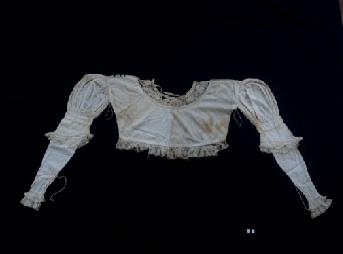 |
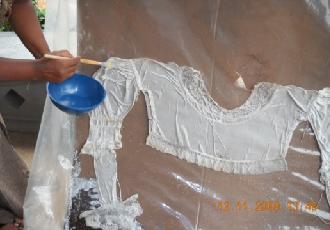 |
| Before conservation |
Mechanized clearing |
|
|
 |
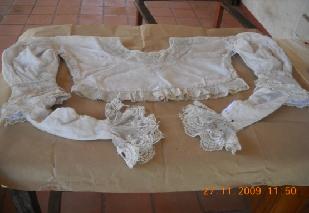 |
| Strengthening with supportive material |
After conservation |
Top



